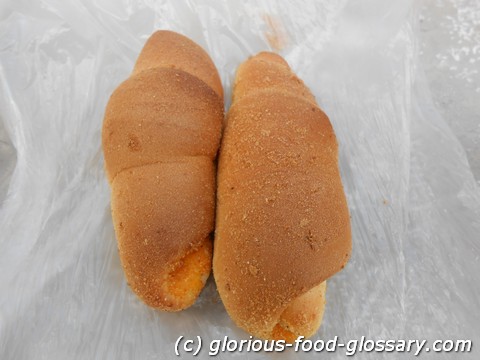Deutsch: Spanisches Brot / Español: Pan Español / Português: Pão Espanhol / Français: Pain Espagnol / Italiano: Pane Spagnolo
Spanish Bread in the food context refers to a popular Filipino bakery item, rather than a bread originating from Spain. It's a soft, sweet bread roll that's rolled in fine breadcrumbs before baking and filled with a sweet, buttery paste often made from a mixture of butter, sugar, and sometimes milk powder. Despite its name, Spanish Bread has its roots firmly in Filipino culinary traditions and is a favorite snack or breakfast item in the Philippines.
Description
The bread is characterized by its fluffy, soft texture and the sweet, rich filling that contrasts beautifully with the slightly crisp outer layer coated in breadcrumbs. The filling is spread onto a flattened piece of dough, which is then rolled to encase the filling before the final roll in breadcrumbs. It's typically baked until golden brown, resulting in a delightful combination of textures and flavors.
Application Areas
Spanish Bread is commonly found in Filipino bakeries and is a staple in the array of breads offered, alongside other favorites like Pandesal and Ensaymada. It's enjoyed by people of all ages and is often paired with coffee or hot chocolate, making it a popular choice for merienda (afternoon snack) or breakfast. Its availability and popularity make it a comforting and familiar treat for many Filipinos, both in the Philippines and abroad.
Well-Known Examples
While Spanish Bread itself is a unique offering, it shares similarities with other filled breads in Filipino cuisine, such as Pan de Coco (coconut-filled bread) and Ensaymada (a sweet bread topped with butter, sugar, and cheese). Each of these breads highlights the Filipino love for sweet, enriched breads that cater to the local palate.
Treatment and Risks
Spanish Bread, like most bakery items, is best enjoyed fresh on the day it's baked. It's relatively high in carbohydrates and sugar, making moderation key for those monitoring their sugar intake or following a specific diet. However, it poses no significant health risks when consumed as part of a balanced diet.
Summary
Spanish Bread stands as a testament to the rich and diverse culinary landscape of the Philippines, blending the influences of its colonial history with local tastes and ingredients. This sweet, soft bread roll, beloved across the country, showcases the simplicity and comfort found in Filipino baking, making it a cherished snack that evokes a sense of home and tradition.
--

Related Articles to the term 'Spanish Bread' | |
| 'Sobaos' | ■■■■■■■■■ |
| Sobaos refers to a Spanish sponge cake, particulary served as dessert or snack or even as breakfast food. . . . Read More | |
| 'Kapet' | ■■■■■■■■■ |
| Kapet is an Ilocano dish which is made of glutinous rice. It is similar to Tikoy or a Tikoy itself, but . . . Read More | |
| 'Rosquillos' | ■■■■■■■■ |
| Rosquillos is a Filipino Biscuit with a name that is derived from the Spanish word \'rosca\' meaning . . . Read More | |
| 'Nankhatai / Nan Khatai' | ■■■■■■■■ |
| Nankhatai / Nan Khatai: Nankhatai refer to popular Indian short bread cookies/biscuits which is made . . . Read More | |
| 'Nankhatai' | ■■■■■■■■ |
| Nankhatai refer to popular Indian short bread cookies/biscuits which is made from gram flour, ghee, sugar . . . Read More | |
| 'Kamoteng Kahoy' | ■■■■■■■■ |
| Kamoteng Kahoy is a Filipino word for Cassava. It is also known as Yucca. In the Philippines, Kamoteng . . . Read More | |
| 'Pastry' | ■■■■■■■■ |
| Pastry is baked food made with a dough of flour, water and shortening . . . . . . Read More | |
| 'Chiffon Cake' | ■■■■■■■■ |
| Chiffon Cake in the food context refers to a light, airy cake that combines the richness of a butter . . . Read More | |
| 'Egg Pie' | ■■■■■■■■ |
| Egg Pie in the food context refers to a popular dessert in the Philippines, similar to the classic custard . . . Read More | |
| 'Halaya' | ■■■■■■■■ |
| Halaya, in the food context, refers to a popular Filipino dessert known as Ube Halaya or Purple Yam Jam. . . . Read More | |
